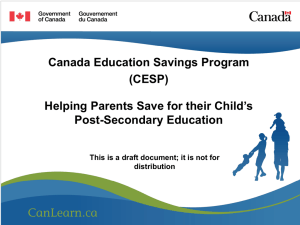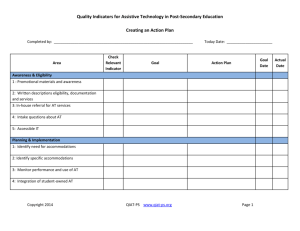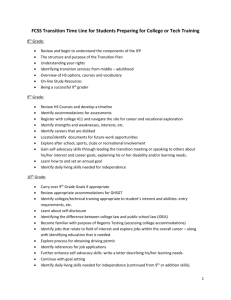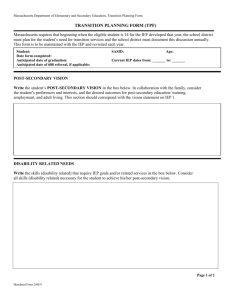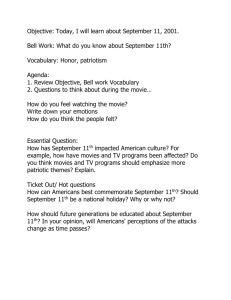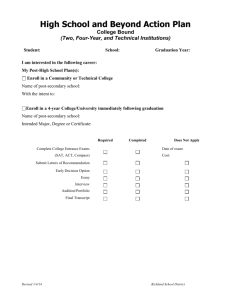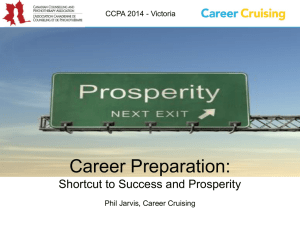Where am I going in the 11th Grade
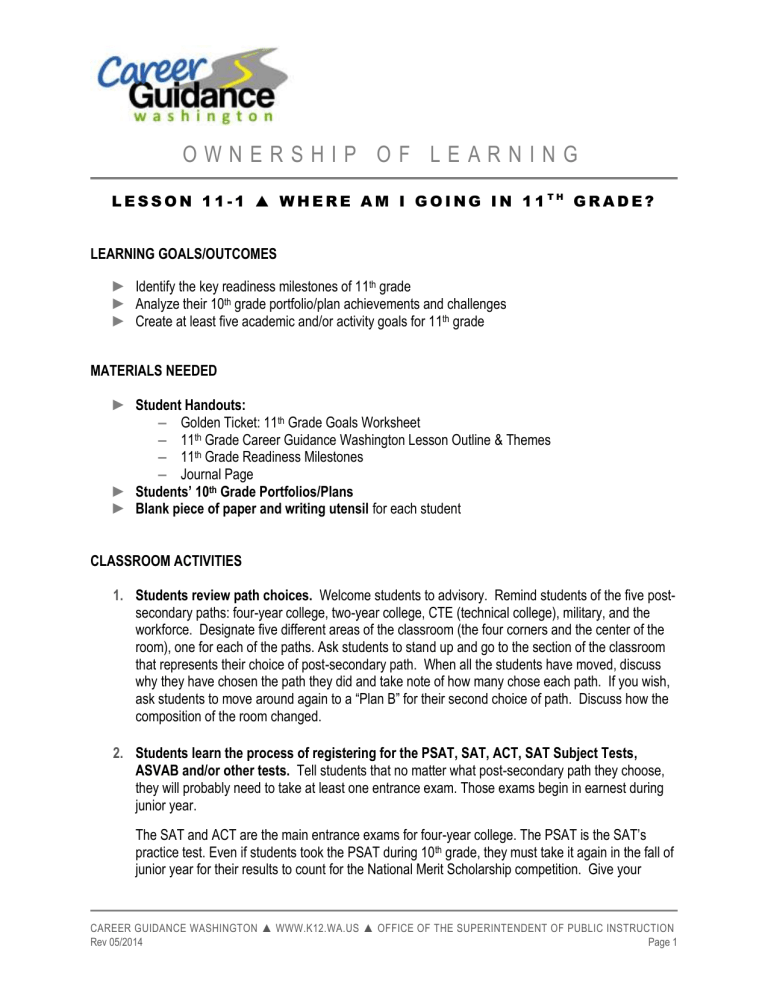
O W N E R S H I P O F L E A R N I N G
L E S S O N 1 1 - 1 W H E R E A M I G O I N G I N 1 1
LEARNING GOALS/OUTCOMES
T H G R A D E ?
► Identify the key readiness milestones of 11 th grade
► Analyze their 10 th grade portfolio/plan achievements and challenges
► Create at least five academic and/or activity goals for 11 th grade
MATERIALS NEEDED
► Student Handouts:
– Golden Ticket: 11 th Grade Goals Worksheet
– 11 th Grade Career Guidance Washington Lesson Outline & Themes
– 11 th Grade Readiness Milestones
– Journal Page
► Students’ 10 th Grade Portfolios/Plans
► Blank piece of paper and writing utensil for each student
CLASSROOM ACTIVITIES
1.
Students review path choices. Welcome students to advisory. Remind students of the five postsecondary paths: four-year college, two-year college, CTE (technical college), military, and the workforce. Designate five different areas of the classroom (the four corners and the center of the room), one for each of the paths. Ask students to stand up and go to the section of the classroom that represents their choice of post-secondary path. When all the students have moved, discuss why they have chosen the path they did and take note of how many chose each path. If you wish, ask students to move around again to a “Plan B” for their second choice of path. Discuss how the composition of the room changed.
2.
Students learn the process of registering for the PSAT, SAT, ACT, SAT Subject Tests,
ASVAB and/or other tests. Tell students that no matter what post-secondary path they choose, they will probably need to take at least one entrance exam. Those exams begin in earnest during junior year.
The SAT and ACT are the main entrance exams for four-year college. The PSAT is the SAT’s practice test. Even if students took the PSAT during 10 th grade, they must take it again in the fall of junior year for their results to count for the National Merit Scholarship competition. Give your
CAREER GUIDANCE WASHINGTON ▲ WWW.K12.WA.US ▲ OFFICE OF THE SUPERINTENDENT OF PUBLIC INSTRUCTION
Rev 05/2014 Page 1
11-1 ▲ WHERE AM I GOING IN 11 TH GRADE? students information about what they should do to register. Your school counseling office may have prepared information for juniors at your school. Even students who are not sure they want to go to four-year college should be encouraged to take the PSAT. Students can learn more about the PSAT at www.collegeboard.com.
3.
In addition, students will begin to register for and take other post-secondary exams junior year, depending on their chosen path. Students can learn more about each of these exams and their registration processes at the following Internet sites:
– Four-year college: SAT, SAT Subject Tests: www.collegeboard.com
– Four-year college: ACT: www.actstudent.org
– Two-year college: ACCUPLACER: www.collegeboard.com
– Military: ASVAB: www.asvabprogram.com
4.
Students identify the key readiness milestones for 11 th grade. Have students sit in groups based on their choice of post-secondary path. (If some of the groups are too large, subdivide them.) Ask each group to brainstorm a list of the milestones they must accomplish as juniors. Tell students a milestone is a key step in the process of becoming college and career ready. Have one member of each group write their list on the board. Discuss how their answers will help them prepare for their chosen post-secondary paths. Explain that no matter what their path, juniors will be expected to achieve six key milestones this year. Either hand out or project the 11 th Grade
Readiness Milestones handout and briefly review the six milestones with your students:
– Continue the post-secondary preparation process by taking the PSAT
– Prepare to take other post-secondary entrance exams
– Learn about the cost of the post-secondary paths and explore financial aid
– Learn more about financial planning and money management
– Begin the application process for post-secondary choices
– Plan for senior year
5.
Students review the 11 th Grade Career Guidance Washington Lesson Outline and Themes.
Remind students that 11 th Grade Career Guidance Washington lessons will help them reach these milestones. Hand out the 11 th Grade Career Guidance Washington Lesson Outline and Themes handout and briefly review it with students.
6.
Students analyze their 10 th grade portfolio/plan achievements and challenges. Hand out students’ portfolios and have them quickly review the contents from 10 th grade. Ask students to take out a piece of paper and write a short paragraph on what they think would most impress an interviewer about their portfolio (a college admissions officer, military recruiter, or employer depending on their chosen path) and what they can improve during 11 th grade. If you wish, have students share these thoughts with their groups. Then ask students to store their paragraph on the inside the front of their portfolios.
7.
Students create at least five academic and activity goals for 11 th grade. Hand out the Golden
Ticket – 11 th Grade Goals Worksheet and tell students they are going to write their “ticket” to their chosen post-secondary path. Ask students to complete the short answer sections on the front of the ticket and then turn it over and write the longer goal statements. Remind students that these
CAREER GUIDANCE WASHINGTON ▲ WWW.K12.WA.US ▲ OFFICE OF THE SUPERINTENDENT OF PUBLIC INSTRUCTION
Rev 05/2014 Page 2
11-1 ▲ WHERE AM I GOING IN 11 TH GRADE? goal statements will be reported on in mid-year and reviewed as part of their 11 th grade student-led conference.
8.
Students reflect on strengths based on post-secondary goals. Ask students to use the
Journal Page handout to answer the following questions:
– What is my greatest strength as I prepare for post-secondary?
– How will this strength help me prepare?
– How will this strength help me make a good impression on a college admissions officer, military recruiter, or employer?
STUDENT PRODUCTS
► Reflective paragraph regarding 10 th grade portfolio achievements and recommended improvements for 11 th grade portfolio
► Completed Golden Ticket: 11 th Grade Goals Worksheet to be placed in their 11 th grade portfolio
► Completed Journal Page
CAREER GUIDANCE WASHINGTON ▲ WWW.K12.WA.US ▲ OFFICE OF THE SUPERINTENDENT OF PUBLIC INSTRUCTION
Rev 05/2014 Page 3
O W N E R S H I P O F L E A R N I N G
L E S S O N 1 1 - 1 H A N D O U T
G O L D E N T I C K E T : 1 1 T H G R A D E G O A L S W O R K S H E E T
This is your Golden Ticket to post-secondary. But you have to figure out how to make this ticket work!
My chosen post-secondary path (circle one)
Four-year College Two-year College CTE
The classes I need to take to qualify for my path
Military Workforce
The entrance exams I need to take to qualify for my path
The recreation and volunteer activities that will help me toward my path
The research I need to do to learn more about my path and how to prepare
Turn this sheet over and write a goal statement for the year. Your 11 th grade goals must include at least two academic goals, two activity goals, and one goal relating to your chosen post-secondary path.
Rev 05/2014 Page 1
O W N E R S H I P O F L E A R N I N G
1 1 T H
L E S S O N 1 1 - 1 H A N D O U T
G R A D E C A R E E R G U I D A N C E L E S S O N O U T L I N E &
T H E M E S
OUTLINE
11-1 Where Am I Going in 11 th Grade?
11-2 Make Sure Your Study Habits Match Your Goals
11-3 Junior-Senior Calendar
11-4 Personal Character Traits
11-5 Balanced Career/Life Planning
11-6 College Searches
11-7 SAT and ACT Strategies
11-8 Postsecondary Admission Requirements
11-9 High School and Beyond Plan
11-10 Course Registration
11-11 Creating an Effective Resume
11-12 Academic Progress Review
11-13 College Inquiries
11-14 More Career Options Than You Can Imagine
11-15 Postsecondary Application
11-16 Preparing for the College Application Essay
11-17 Financial Aid Fundamentals
11-18 And Investment in the Future
11-19 Preparing for Student-led Conferences I
11-20 Preparing for Student-led Conferences II
THEMES
What makes a student college and career ready? Career Guidance Washington addresses 7 themes important to a college and career ready student:
Career and College Development
Ownership of Learning
Transition Skills
Learning Techniques
Metacognitive Skills
Academic Eligibility
High School and Beyond Plan
Rev 05/2014 Page 1
O W N E R S H I P O F L E A R N I N G
L E S S O N 1 1 - 1 H A N D O U T
1 1 T H G R A D E R E A D I N E S S M I L E S T O N E S
Junior year is very important for students who are preparing for their chosen post-secondary path. As a junior, you will reach six key milestones this year:
MILESTONE 1: Continue the post-secondary preparation process by taking the PSAT. Whether or not you think you want to go to a four-year college, it is a good idea to be prepared. Taking the PSAT during junior year will help you assess your academic skills, prepare you for the SAT, and enter you into the
National Merit Scholarship competition.
MILESTONE 2: Prepare to take other post-secondary entrance exams. No matter what your chosen post-secondary path, you will likely need to take at least one entrance exam. During junior year, you’ll learn about the entrance exams for each path – from the SAT and ACT for four-year college to the ASVAB for the military and ACCUPLACER for two-year college – and you’ll learn when you should take them and what you should do to prepare.
MILESTONE 3: Learn about the cost of the post-secondary paths and explore financial aid. If you have chosen one of the three college paths, you’ll need to develop a plan to pay for tuition and other expenses. This year you will learn about financial aid, including the scholarships, grants, loans, and parttime jobs that many students use to pay for college. You will continue the process of developing a financial plan for your life after high school.
MILESTONE 4: Learn more about financial planning and money management. In addition to focusing on financial aid, you will also learn more about managing money responsibly when you are an adult. You’ll learn about borrowing, saving, and investing money. And you’ll learn how to use credit wisely so that you do not end up with too much debt to repay.
MILESTONE 5: Begin the application process for post-secondary choices. No matter what your chosen path, you will take important steps during junior year to begin the application process. You might research colleges and majors and visit college campuses, talk with a military recruiter, or begin the work of qualifying for an apprenticeship. This year you’ll learn more about the process to prepare for postsecondary.
MILESTONE 6: Plan for senior year. Senior year is very important because it’s your last year in high school – your last chance to prepare for your post-secondary path. Because senior year is so important, you’ll spend time this year planning the courses you should take and the activities you should join when you are a senior.
Rev 05/2014 Page 1
O W N E R S H I P O F L E A R N I N G
L E S S O N 1 1 - 1 H A N D O U T
J O U R N A L P A G E
Lesson 11-1
|
WHERE AM I GOING IN 11
TH
GRADE?
Q1: What is my greatest strength as I prepare for postsecondary?
Q2: How will this strength help me prepare?
Q3: How will this strength help me make a good impression on a college admissions officer, military recruiter or employer?
Answers:
Rev 05/2014 Page 1
